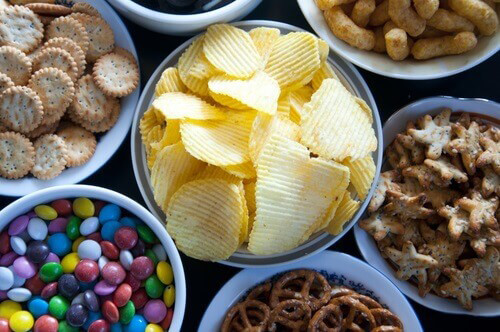Updated January 2025
We love our snacks, but studies show that our grazing habits and unhealthy snacking are contributing to the nation’s obesity epidemic.
As a nation, our eating habits have undergone a seismic shift over the last few decades and it’s having a seismic impact on our waistlines, too. A generation ago, most meals were consumed at mealtimes – we sat at a table with family members. But now we are a nation of noshers, grazers and snackers. A recent article in Vox shows that obesity in America is more about snacks than giant meals.
“… a table from David Cutler, Jesse Shapiro, and Ed Glaeser’s 2003 study “Why have Americans become more obese” … shows is that pretty much all of America’s increased calorie consumption between the late-1970s and the mid-1990s came from increased snacking. Women actually started eating smaller meals during this period, they just more than made up for it with snacks.
That data is a little out of date, but according to Professor Richard Mattes the snack explosion only continued. In 1996, the average American ate about 423 calories worth of snacks per day but by 2006 that was up to 580.”
According to an article about grazing & snacking in Consumer Reports:
“The snack-food market is a $33-billion business in the U.S. Ninety percent of adults nosh on any given day, according to the National Health and Nutrition Examination Survey—and about 40 percent munch on snacks three times a day or more.”
For some people, snack foods are “in addition to” eating, while for others, snacks are a meal replacement. There are many lifestyle factors contributing to the growth in unhealthy snack habits, but a large part of the problem lies in the widespread availability of snacks. Unfortunately, so many snacks of choice aren’t fruits and veggies but unhealthy packaged “treats” loaded with fats, salts and sugars. Even many of the so-called “healthy” and “natural” snacks really aren’t.
“Our food-test team took a close look at foods often eaten as snacks that carry protein claims. In comparing those foods with their regular versions, we found that “protein” doesn’t always mean “healthy” (or tasty, for that matter). Snack bars, popular and portable, also have a health halo but can contain highly processed ingredients or so much sugar and fat that you might as well have a candy bar.”
For some populations, snacking may serve a purpose. The article quotes nutritionist Claire Zizza who says that snacking can be beneficial for children and seniors, two groups “who often don’t eat or drink enough during meals to meet their nutrient needs.” Conventional wisdom seems to hold that more frequent, smaller meals can be helathier than a few larger meals but studies don’t bear that out. In fact, the article points to some studies that contradict this.
Here are tips to help curb the snacking habit:
- Eat balanced meals that include proteins to stay full.
- Don’t rush your meals – take time to savor your food. Do that with snacks, too. Sit and enjoy any that you do have.
- Plan and schedule snacks in advance. Train yourself to minimize impulse or unplanned eating.
- Minimize temptation. Don’t keep junk food at home or the workplace. Have healthy, low-calorie snacks that you like on hand instead: yogurt, nuts, fruit, veggies.
- Portion control snacks. Don’t bring the entire box or bag to your desk, your TV room or your bedside table.
- Drink more water between meals. It can be filling.
- Distract yourself. Are you hungry or bored? Do something to keep your mind occupied.
- Postpone. Sometimes when you feel hungry, you can work past it. Try waiting 15 minutes – you may forget.
Our TotalCare Wellness Nutrition Coaches have more Member tips for healthy snacks and healthy eating!

